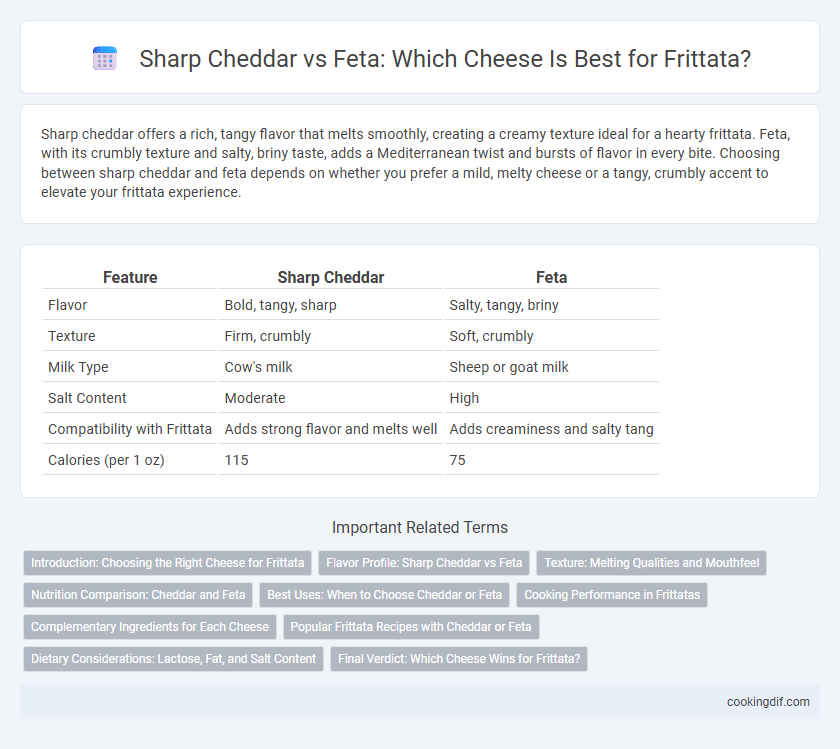Sharp cheddar offers a rich, tangy flavor that melts smoothly, creating a creamy texture ideal for a hearty frittata. Feta, with its crumbly texture and salty, briny taste, adds a Mediterranean twist and bursts of flavor in every bite. Choosing between sharp cheddar and feta depends on whether you prefer a mild, melty cheese or a tangy, crumbly accent to elevate your frittata experience.
Table of Comparison
| Feature | Sharp Cheddar | Feta |
|---|---|---|
| Flavor | Bold, tangy, sharp | Salty, tangy, briny |
| Texture | Firm, crumbly | Soft, crumbly |
| Milk Type | Cow's milk | Sheep or goat milk |
| Salt Content | Moderate | High |
| Compatibility with Frittata | Adds strong flavor and melts well | Adds creaminess and salty tang |
| Calories (per 1 oz) | 115 | 75 |
Introduction: Choosing the Right Cheese for Frittata
Sharp cheddar offers a bold, tangy flavor and melts smoothly, creating a rich, creamy texture in frittatas. Feta provides a crumbly, salty bite with a slightly tangy profile that adds a Mediterranean twist and distinct texture. Selecting between sharp cheddar and feta depends on whether you prefer a robust, melty cheese or a briny, crumbly contrast to complement your eggs.
Flavor Profile: Sharp Cheddar vs Feta
Sharp cheddar offers a bold, tangy flavor with a creamy texture that enhances the richness of a frittata, creating a savory and slightly nutty taste. Feta provides a salty, briny flavor with a crumbly, slightly grainy texture that adds a bright, tangy contrast and a Mediterranean flair. Choosing between sharp cheddar and feta in a frittata depends on whether you prefer a robust, creamy depth or a tangy, salty bite in your dish.
Texture: Melting Qualities and Mouthfeel
Sharp cheddar melts smoothly in a frittata, creating a creamy and rich texture that enhances each bite with a velvety mouthfeel. Feta, while offering a crumbly texture, does not melt fully, providing a tangy, slightly grainy contrast that adds a distinct layer of complexity. Choosing sharp cheddar results in a cohesive, gooey consistency, whereas feta maintains pockets of crumbly, salty bursts within the fluffy egg base.
Nutrition Comparison: Cheddar and Feta
Sharp cheddar contains higher protein and calcium levels compared to feta, providing 7 grams of protein and 200 mg of calcium per ounce, while feta offers 4 grams of protein and 140 mg of calcium per ounce. Cheddar has a higher fat content, including saturated fat, contributing to a creamier texture, whereas feta's lower fat content and higher sodium make it a lighter, saltier choice. Both cheeses supply essential vitamins A and B12, but cheddar's richer nutrient density supports muscle maintenance and bone health more effectively.
Best Uses: When to Choose Cheddar or Feta
Sharp cheddar is ideal for frittatas that benefit from a rich, creamy melt and a robust, tangy flavor, enhancing ingredients like potatoes, bacon, or sauteed mushrooms. Feta cheese works best in Mediterranean-style frittatas, adding a crumbly texture and a salty, briny taste that complements spinach, tomatoes, and olives. Choose cheddar for a smoother, uniform melt and feta for a more distinct, chunky bite.
Cooking Performance in Frittatas
Sharp cheddar melts smoothly in frittatas, creating a creamy texture that enhances the eggs without overpowering other flavors. Feta retains its crumbly texture when cooked, providing distinct salty pockets that add bursts of tanginess and a Mediterranean profile. Choosing between sharp cheddar and feta depends on whether a uniform melt or contrasting texture is preferred for the frittata's overall taste and mouthfeel.
Complementary Ingredients for Each Cheese
Sharp cheddar enhances a frittata with complementary ingredients like caramelized onions, spinach, and smoked bacon, adding rich, savory depth. Feta pairs well with sun-dried tomatoes, olives, and fresh herbs such as dill or oregano, providing a tangy, Mediterranean flavor profile. Choosing the right cheese depends on the desired taste balance and regional ingredient style in the frittata.
Popular Frittata Recipes with Cheddar or Feta
Sharp cheddar offers a rich, tangy flavor and melts smoothly in popular frittata recipes, creating a creamy texture that complements ingredients like spinach or bacon. Feta, known for its crumbly texture and salty, briny taste, adds a Mediterranean twist to frittatas featuring tomatoes, olives, or herbs. Both cheeses enhance frittatas uniquely, with sharp cheddar delivering a hearty bite and feta providing a lighter, tangy contrast.
Dietary Considerations: Lactose, Fat, and Salt Content
Sharp cheddar contains more lactose and saturated fat compared to feta, which is generally lower in lactose and offers a tangier, saltier flavor. Feta typically has higher sodium levels, making it less suitable for low-sodium diets, while sharp cheddar provides a richer source of protein and calcium. Choosing between the two depends on dietary restrictions related to lactose intolerance, fat intake, and sodium sensitivity.
Final Verdict: Which Cheese Wins for Frittata?
Sharp cheddar offers a rich, creamy texture and bold flavor that melts smoothly, enhancing the frittata's savory profile. Feta delivers a tangy, crumbly texture with a salty bite that adds brightness and a Mediterranean flair. For a classic, hearty frittata, sharp cheddar wins, while feta is ideal for a lighter, more vibrant twist.
Sharp cheddar vs feta for cheese Infographic

 cookingdif.com
cookingdif.com